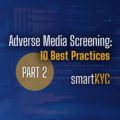In 2004, a colleague and I had the idea of building a search string of negative words in several languages and applying that to a corpus of news content to support our banking clients with their KYC efforts. Thus was born the world’s first adverse media search tool, Lexis Diligence, and quite some time before the FSA (now Financial Conduct Authority) recommended the use of such tools for KYC.
Today, and now running a KYC technology business, I think it is inevitable that best practice guidance will soon enough be looking to add high frequency monitoring to the two existing KYC pillars of activity, onboarding due diligence and periodic refresh.
But many are daunted by the prospect of implementing a high frequency KYC monitoring programme – the prohibitive capital costs, the huge increase in operating expenditure to manage the increased workload, the nightmare scenario of creating another transaction monitoring-type SAR’s headache – it’s hard to know where to start.
Being sensible and specific about what you wish to monitor, searching foreign language material with confidence, selecting source material wisely, avoiding repetition and managing search footprint.
Despite the challenges, we sense an increased appetite by banks to stay one step ahead of the regulator by implementing a high frequency monitoring programme. So, with the benefit of the last 15 years’ experience in the field, here are the main challenges and how to overcome them.
In two articles for Money Laundering Bulletin, Dermot Corrigan of smartKYC discusses the challenges of implementing a continuous or high frequency KYC monitoring programme.


